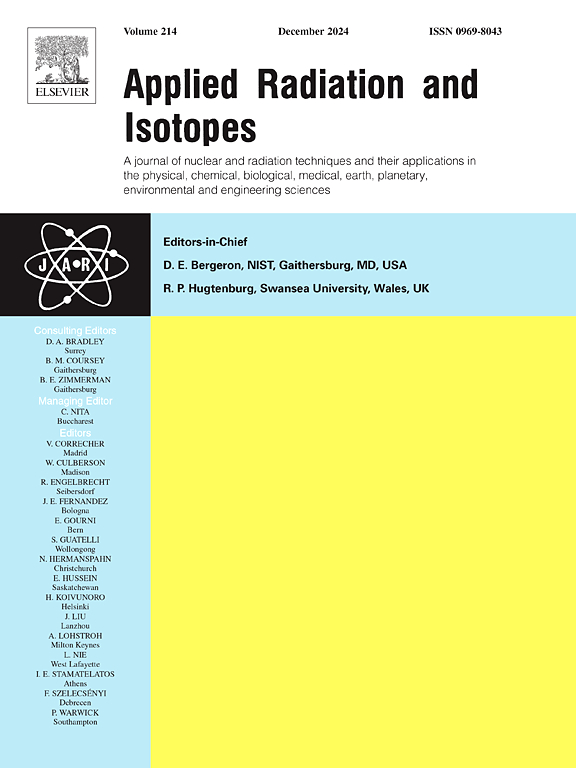Produced radioactive isotopes, ambient dose equivalent in TrueBeam room with flattening filter (FF) and Flattening Filter Free (FFF) modes: Monte Carlo simulation
IF 1.6
3区 工程技术
Q3 CHEMISTRY, INORGANIC & NUCLEAR
引用次数: 0
Abstract
Background
High-energy linear accelerators used in radiotherapy produce unexpected neutrons that can activate materials in the treatment room.
Materials and methods
The research group used PHITS code to simulate TrueBeam Linac head with 10 MV photons. Then, PHITS codes connected Dchain code to calculate the variation of the induced radioactivity, the ambient dose equivalent during TrueBeam radiation 4 Gy with dose rate 400 MU (Monitor Unit)/minute in FF mode, 24 Gy with dose rate 2400 MU/minute in FFF mode, and cooling time (14 min).
Results
One minute of beam-on TrueBeam with 10 MV photon energy produced six mainly produced nuclides (183 mW, 24mNa, 185 mW, 28Al, 24mNa, and 187W). FFF mode had more activity of the produced isotopes than those in FF mode (1.60 × 1014 Bq compared with 1.57 × 1014 Bq—corresponding to ∼1.71% higher). The differences in the activity of isotopes and ambient dose between FF and FFF mode were mostly less than a few percent; however, considering that the MU per beam current is six times higher in the FFF mode than in the FF mode, the induced activities per MU can be reduced by roughly six times when using the FFF mode instead of the FF mode.
Conclusion
The isotope activities of the produced isotopes in the FF and FFF modes are essentially equivalent when normalized per beam current.
求助全文
约1分钟内获得全文
求助全文
来源期刊

Applied Radiation and Isotopes
工程技术-核科学技术
CiteScore
3.00
自引率
12.50%
发文量
406
审稿时长
13.5 months
期刊介绍:
Applied Radiation and Isotopes provides a high quality medium for the publication of substantial, original and scientific and technological papers on the development and peaceful application of nuclear, radiation and radionuclide techniques in chemistry, physics, biochemistry, biology, medicine, security, engineering and in the earth, planetary and environmental sciences, all including dosimetry. Nuclear techniques are defined in the broadest sense and both experimental and theoretical papers are welcome. They include the development and use of α- and β-particles, X-rays and γ-rays, neutrons and other nuclear particles and radiations from all sources, including radionuclides, synchrotron sources, cyclotrons and reactors and from the natural environment.
The journal aims to publish papers with significance to an international audience, containing substantial novelty and scientific impact. The Editors reserve the rights to reject, with or without external review, papers that do not meet these criteria.
Papers dealing with radiation processing, i.e., where radiation is used to bring about a biological, chemical or physical change in a material, should be directed to our sister journal Radiation Physics and Chemistry.
 求助内容:
求助内容: 应助结果提醒方式:
应助结果提醒方式:


